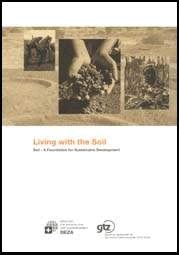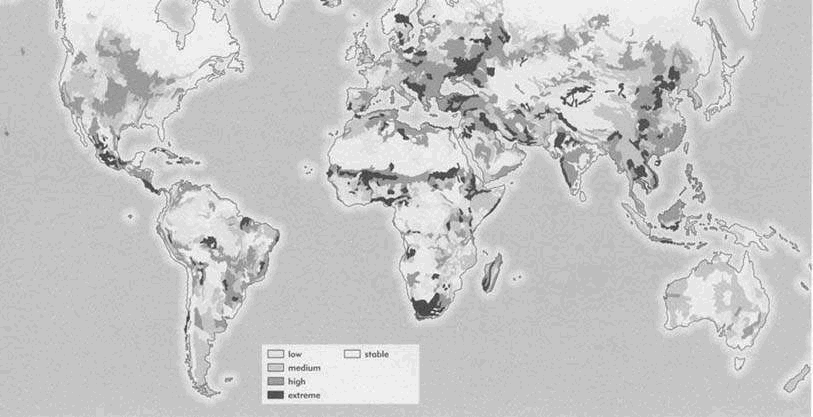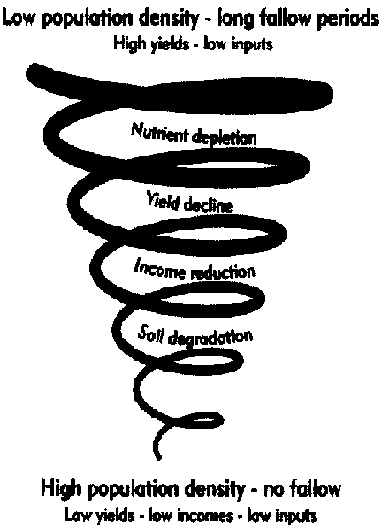
Soil - The Limits to Renewal[edit | edit source]
The soil is inseparable not only from human life, but also from that of countless other terrestrial life forms. As the worldÂ's population has grown, the pressure to exploit soil resources has risen continuously. However, there is barely any suitable land left that is not already under agricultural use. The major challenge is therefore to increase yields by managing existing agricultural land more productively, yet at the same time sustainably. Above all, this calls for ecologically sound soil management. Yet it will also require the substitution of withdrawn nutrients and degraded organic matter with organic and mineral fertilisers.
World-wide soils are threatened by degradation
Most countries are affected by soil degradation. This can manifest itself in a variety of ways. In the North, soil compaction results from heavy agricultural machinery and the accumulation of pollutants caused by industrial emissions. By contrast, in the South soil erosion and impoverishment result from inappropriate cropping methods.
The soil is vulnerable. One violent rainstorm can destroy what took centuries to build up. After the storm, torrential brown streams carry away fertile earth. Mud gushes out of the land. Yet new soil is formed only very slowly from the disintegration of rock, plant residues and soil organisms. Only fractions of a millimetre are created per annum by weathering. By contrast, erosion can destroy many centimetres over the same period.
Soil is a dynamic resource. It constantly seeks a new equilibrium. Ideally, the formation of fresh nutrients is roughly proportionate to withdrawal through plant growth. Plants and animals withdraw nutrients, which are replaced by dying matter. This can be seen particularly impressively in the rainforest. At the surface of the heavily weathered, nutrient-poor soils, a largely closed system of enormous biodiversity forms. Nutrient formation and withdrawal remain more or less in a state of equilibrium. Clearance of virgin forest interrupts this cycle of nutrient replenishment and withdrawal. Organic matter is rapidly degraded, the minerals released are leached out. The soil also increasingly loses its capacity to retain water. Fertility and productivity diminish.
The soil is subject to a diverse range of pressures. Only an estimated 11% of the earthÂ's surface is suitable for agricultural use. This area must satisfy the various basic needs of humankind. And as the worldÂ's population grows, so too do those needs. Today, virtually all land suitable for agriculture is already being utilised for that purpose. Spare land has become scarce. Consequently, people the world over are increasingly starting to utilise steep slopes threatened by erosion, dry zones, and forest areas worthy of conservation. It is therefore necessary to manage existing agricultural land more productively and sustainably.
Poverty and natural resource degradation - a vicious circle
Poverty prevents long-term planning. Lack of income makes it more difficult for small farmers to increase production by applying fertilisers or new cropping methods. Creeping soil degradation thus reduces the productivity of the soil, and once a certain point is reached the process becomes irreversible. Further impoverishment results, which in turn causes migration and armed conflicts. In other words, war is often also caused to some extent by a scarcity of land, water and vegetation resources. This is why poverty alleviation, food security and natural resource management are top-priority goals of international development cooperation. (Quelle: IBSRAM)
|
· Every year, inappropriate management destroys 5-7 million hectares of agricultural land. This is equivalent to 0.3 - 0.5% of total agricultural land, an area the size of Togo or Sierra Leone. · Soil degradation is reducing the world grain harvest by 1% per annum, i.e. 12.7 tons. · Those 12.7 million tons could ensure the survival of 63.5 million people. |

